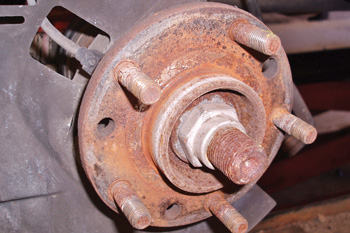Sealed wheel bearing hub assemblies have become standard equipment on the majority passenger vehicles and light-duty trucks because they operate with zero end-play, which reduces rotating friction on the brakes and also because they require no periodic adjustment and lubrication. In four-wheel, all-wheel and front-wheel drive applications, the wheel bearing hub assembly is made with two opposing bearings, and with the inner bearing races pressed onto a splined hub that slips over the splined axle shaft.
 Non-driving hubs simply mount to the axle or suspension knuckle with the wheel bolted to the inner spindle of the hub. Since some wheel bearing hub assemblies have the anti-locking brake wheel speed sensor built as an integral part of the hub, the hub must be replaced if the wheel speed sensor fails.
Non-driving hubs simply mount to the axle or suspension knuckle with the wheel bolted to the inner spindle of the hub. Since some wheel bearing hub assemblies have the anti-locking brake wheel speed sensor built as an integral part of the hub, the hub must be replaced if the wheel speed sensor fails.
In most applications, a wheel bearing hub will last through the normal service life of a vehicle. On the other hand, wheel bearing hub assemblies usually begin to fail after the vehicle has been exposed to deep, muddy water encountered in mountain streams or flooded intersections. The first indications of a worn bearing hub assembly are ticking or grinding noises that increase in frequency with vehicle speed. In most cases, turning a sharp corner in one direction or another will increase the noise level of a defective wheel bearing. Wear in the wheel bearing can be such that the anti-lock braking (ABS) reluctor will contact the ABS wheel speed sensor, which will cause a C0-series diagnostic trouble code to be stored in the ABS module and the orange ABS warning light to illuminate.
Bearing Hub Inspections
As mentioned above, modern wheel bearing hub assemblies are designed to operate with zero end-play in the bearings. A worn bearing can therefore be detected by placing a vehicle on a lift and grasping the wheel at the 12 o’clock and 6 o’clock positions. If looseness in the wheel bearings is detected, the hub should be replaced. Since the wheel bearings are operated in an unloaded position when the vehicle is suspended on a chassis lift, it’s difficult to locate bearing noises with the engine running and transmission engaged. In some cases, a set of electronic microphones or “ears” designed to locate chassis noises can help pinpoint the defective bearing. But, even when the defective bearing is located, it’s still best to sell wheel bearing hubs in axle sets because both tend to wear at the same rate.
Installation Tips
Wheel bearing hub assemblies fit into a precisely machined recess in the steering knuckle. The hub assembly is then held in place by specially hardened bolts. Unfortunately, bearing hub assemblies tend to rust in place when continuously exposed to water or road salt and can therefore become very difficult to remove. In any case, applying a professional grade penetrating oil and using some judicious hammer work to loosen the old bearing hub will work most of the time. If the bearing hub is installed in an aluminum steering knuckle, heating the knuckle with a hot air gun can help loosen the steel hub from the aluminum knuckle. In any case, never heat suspension components with an acetylene or propane welding torch since doing so might weaken the knuckle.




